Album title: Gustav Mahler's Symphony No. 9 in D major
Performers: Carlo Maria Giulini, Chicago Symphony Orchestra
Label: Speakers Corner DG 2707097
Playing time: 2 LPs: 31’45"/17’05"/13’53"/25’12"
Recorded: 1977

Perhaps the most autobiographical symphonist of all times, it is Gustav Mahler’s Symphony No.9 that entrances the most interpretational theorists to decipher its true meaning. From a purely technical standpoint all seem to agree that the work was Mahler’s farewell to tonality, exerting tremendous influence on the New Viennese School noticeably in the final movement. What leads to differences or similarities in interpretation depends on the conductors’ treatments of the score. But conductors seldom write down their notes at least not in the seventies when this recording was first released. Unless you had the privilege of being present during rehearsal, our conjecture of a conductor’s interpretation hinges on just one thing - gut feeling.

This symphony was written between 1908 and 1909. If one accepts the so-called ‘death-haunted symphony’ theory, one’s postmortem must trace back to 1907 when life’s various adversities struck Mahler all at once. First scarlet fever took the life of his elder daughter Maria. Then his heart condition was diagnosed as life-threatening. But the real heartbreak was discovering that his wife Alma had an affectionate affair with another man. At the end of the same year Mahler finally succumbed to his opponents and resigned from the Vienna Court Opera after years of battles.
Whether we subscribe to reading between the lines or not, the symphony is undeniably a farewell of some sort as hinted at by the first movement’s quote from Beethoven’s ‘Les Adieux’ Sonata. What remains inconclusive amongst performers and listeners alike is who the farewell was addressed to and what kind of spiritual mood Mahler was under at the time. I personally would not confine myself to one definitive interpretation when I’ve found very polarizing views equally as convincing.
Under the broad catch-all ‘Farewell to Life’ some commentators have drawn comparisons between Mahler’s Ninth and Tchaikovsky’s Sixth, the so-called ‘Pathetique’. In his last symphony Tchaikovsky’s farewell to life was expressed in lachrymose outbursts almost suicidal in tenor despite the bittersweet memories recollected in the second movement. One interpretation of Mahler’s Ninth that seems to entail similar pathetiquette is Gary Bertini’s 1991 reading with the Cologne Radio Symphony Orchestra [EMI CDS 7543872], a decisively direct and focused take that avoids all trivialities and whose two outer movements plunge into an emotional abyss with a heart as heavy as lead.

Giulini’s reading on the other hand confirms the prevalent notion that Mahler’s musical language was far more complex than Tchaikovsky’s. Mahler’s farewell according to Giulini—or rather my take on him—is not entirely of despair but a mix of yearning for love, reconciliation, atonement and even comfort and ultimate resolution. In 1902 Mahler was the object of jealousy when he married Alma Schindler, nineteen years his junior and Vienna’s most desirable woman known for her youthful beauty, artistic taste, musical talent as song composer and flirtatious vivacity among prominent men in the artistic circle, Gustav Klimt and Alexander von Zemlinsky included.

In the wake of their marital crisis Mahler made up for his earlier dismissive attitude towards Alma’s compositions by publishing her works. Listening to Giulini I couldn’t stop relating Mahler’s Ninth to his own Sixth and even First. Remember Alma’s Theme in the Sixth, the sweepingly passionate melody that comes after the march theme in the first movement? Under Giulini’s baton the Andante comodo opening of the Ninth’s appears like a heartbroken tormented version of Alma’s Theme. Listen carefully to the climax about 10 minutes in. Isn’t that a quick but distorted flashback of the Sixth’s Scherzo supposedly portraying Mahler’s daughters at play? About two-thirds into the score Bertini’s version depicts funeral-like church bells but not Giulini. Did he use a different score perhaps?
Strangely enough Bertini’s first movement is faster but the more poignant throughout. The tone color is set in a very saturated hue of gray. Giulini’s tempo is slower, the opening strings are somber and stark but the movement soon unfolds into multi-facetted emotional intensity. The climax is the more impactful yet without the slightest trace of indulgence. It eases naturally into the Ländler movement, which again is more colorful than Bertini’s.

For the ‘Farewell’ theorists the Burlesque movement sounds like an echoic but twisted outcry of the First Symphony’s final movement. The rhythmic pulse is so similar that it’s like a haunting shadow. To me this seems more farewell to intellectual freedom. The First or so-called Titan Symphony was inspired by Jean Paul’s satirical writings in which the Titans referred not to Greek mythology but the struggle for intellectual freedom. And the final movement once bore the descriptive title ‘Dall’inferno al Paradiso (Allegro furioso), the sudden expression of the feelings of a deeply wounded heart’. When penning the Ninth Mahler perhaps still sensed the bitter aftertaste from stepping down from the Vienna Court Opera. Bertini’s sarcasm is self-mocking as though Mahler turned the joke on himself. Giulini took a courageous stance by mocking destiny in defiance of death as though underlining the composer’s self-fulfilling prophecy "my time will come".
The same positive attitude carries through to Giulini’s final movement. His tempo is not that slow compared to most – Bertini’s is much slower and imbued with a sense of darkness and exhaustion punctuated with regretful sighs. Like the opening movement, Giulini’s fine balance of orchestral details and timbral nuances ably supported by DG’s sound engineering team gives insight into the inevitable valediction that bravely embraces agonized despair with unquenched love of life.
Although I do not believe in vinyl supremacy, Speakers Corner’s dedication to exacting high standard explains why some do. The ultra-high resolution and lack of surface noise here are commendable.
David Kan
Source